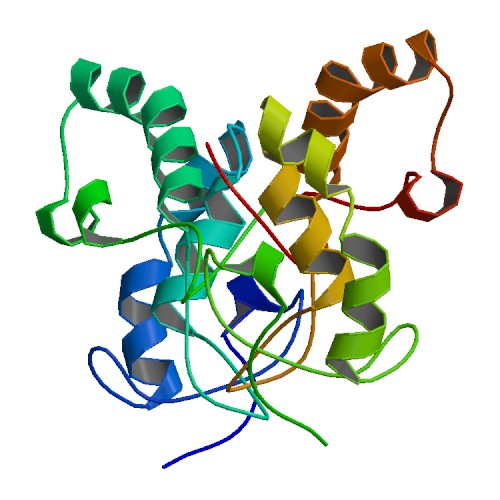FZD8
| Frizzled homolog 8 (Drosophila) | |||||||||||||
|---|---|---|---|---|---|---|---|---|---|---|---|---|---|
 PDB rendering based on 1ijy. | |||||||||||||
| |||||||||||||
| Identifiers | |||||||||||||
| Symbols | FZD8 ; FZ-8; hFZ8 | ||||||||||||
| External IDs | Template:OMIM5 Template:MGI HomoloGene: 40606 | ||||||||||||
| |||||||||||||
| RNA expression pattern | |||||||||||||
 | |||||||||||||
| More reference expression data | |||||||||||||
| Orthologs | |||||||||||||
| Template:GNF Ortholog box | |||||||||||||
| Species | Human | Mouse | |||||||||||
| Entrez | n/a | n/a | |||||||||||
| Ensembl | n/a | n/a | |||||||||||
| UniProt | n/a | n/a | |||||||||||
| RefSeq (mRNA) | n/a | n/a | |||||||||||
| RefSeq (protein) | n/a | n/a | |||||||||||
| Location (UCSC) | n/a | n/a | |||||||||||
| PubMed search | n/a | n/a | |||||||||||
Frizzled homolog 8 (Drosophila), also known as FZD8, is a human gene.[1]
This intronless gene is a member of the frizzled gene family. Members of this family encode seven-transmembrane domain proteins that are receptors for the Wingless type MMTV integration site family of signaling proteins. Most frizzled receptors are coupled to the beta-catenin canonical signaling pathway. This gene is highly expressed in two human cancer cell lines, indicating that it may play a role in several types of cancer. The crystal structure of the extracellular cysteine-rich domain of a similar mouse protein has been determined.[1]
See also
References
Further reading
- Wang Y, Macke JP, Abella BS; et al. (1996). "A large family of putative transmembrane receptors homologous to the product of the Drosophila tissue polarity gene frizzled". J. Biol. Chem. 271 (8): 4468–76. PMID 8626800.
- Finch PW, He X, Kelley MJ; et al. (1997). "Purification and molecular cloning of a secreted, Frizzled-related antagonist of Wnt action". Proc. Natl. Acad. Sci. U.S.A. 94 (13): 6770–5. PMID 9192640.
- Tamai K, Semenov M, Kato Y; et al. (2000). "LDL-receptor-related proteins in Wnt signal transduction". Nature. 407 (6803): 530–5. doi:10.1038/35035117. PMID 11029007.
- Hartley JL, Temple GF, Brasch MA (2001). "DNA cloning using in vitro site-specific recombination". Genome Res. 10 (11): 1788–95. PMID 11076863.
- Saitoh T, Hirai M, Katoh M (2001). "Molecular cloning and characterization of human Frizzled-8 gene on chromosome 10p11.2". Int. J. Oncol. 18 (5): 991–6. PMID 11295046.
- Semënov MV, Tamai K, Brott BK; et al. (2001). "Head inducer Dickkopf-1 is a ligand for Wnt coreceptor LRP6". Curr. Biol. 11 (12): 951–61. PMID 11448771.
- Dann CE, Hsieh JC, Rattner A; et al. (2001). "Insights into Wnt binding and signalling from the structures of two Frizzled cysteine-rich domains". Nature. 412 (6842): 86–90. doi:10.1038/35083601. PMID 11452312.
- Yao R, Maeda T, Takada S, Noda T (2001). "Identification of a PDZ domain containing Golgi protein, GOPC, as an interaction partner of frizzled". Biochem. Biophys. Res. Commun. 286 (4): 771–8. doi:10.1006/bbrc.2001.5430. PMID 11520064.
- Strausberg RL, Feingold EA, Grouse LH; et al. (2003). "Generation and initial analysis of more than 15,000 full-length human and mouse cDNA sequences". Proc. Natl. Acad. Sci. U.S.A. 99 (26): 16899–903. doi:10.1073/pnas.242603899. PMID 12477932.
- Deloukas P, Earthrowl ME, Grafham DV; et al. (2004). "The DNA sequence and comparative analysis of human chromosome 10". Nature. 429 (6990): 375–81. doi:10.1038/nature02462. PMID 15164054.
- Omoto S, Hayashi T, Kitahara K; et al. (2004). "Autosomal dominant familial exudative vitreoretinopathy in two Japanese families with FZD4 mutations (H69Y and C181R)". Ophthalmic Genet. 25 (2): 81–90. doi:10.1080/13816810490514270. PMID 15370539.
- Lu W, Yamamoto V, Ortega B, Baltimore D (2004). "Mammalian Ryk is a Wnt coreceptor required for stimulation of neurite outgrowth". Cell. 119 (1): 97–108. doi:10.1016/j.cell.2004.09.019. PMID 15454084.
This article incorporates text from the United States National Library of Medicine, which is in the public domain.